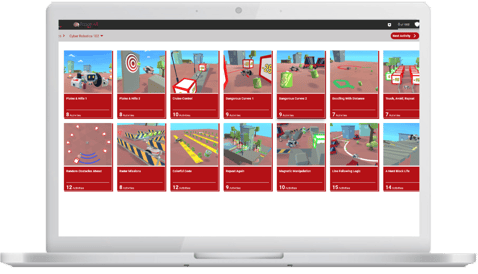By Luke Smith
 Photo by Tirachard Kumtanom from Pexels
Photo by Tirachard Kumtanom from Pexels
In-person science, technology, engineering, and math (STEM) classes have been the standard approach for decades. It’s easy to understand why this is the case, as these subjects aren't just about the theoretical aspects. There are also practical elements that help to provide a rich and effective technical education. As well as reinforcing theory, these practical elements often boost students’ enthusiasm for the fields.
However, as with so many other aspects of our lives, the COVID-19 pandemic served to force schools to make changes. To maintain safe distances, educators, students, and parents have had to adapt to a new manner of learning. This found educators adopting online tools in ways they hadn’t previously considered. As a result, educators proved that STEM education can be effective to some extent in remote circumstances.
A new normal is on the horizon and remote or hybrid teaching may be features of the educational landscape for the foreseeable future. As such, it’s worth examining whether online STEM classes can be more than just an emergency measure, and be adopted as a permanent measure. How can this be made practical, what can students and teachers gain from it, and what are the challenges?
What Has Changed?
A standout element that has arisen through the past year of remote learning is that the curriculum isn’t directly transplantable. As a teacher, you can’t expect to simply connect to students through Skype or Zoom and continue the curriculum as you would in a physical classroom. STEM learning in particular has had to undergo adaptations before solidifying methods that have been both practical and effective. Indeed, many teachers are still trying out elements and discovering what works for their particular area of study. One University of Massachusetts Amherst ecology professor adopted a mixed approach to her labs. She created a program that saw a lecture for one hour before sending students out into the wild to video plant samples. Learners then return to the group session for a specimen sharing discussion. So, remote STEM is certainly possible, and positive, if a more flexible approach to the curriculum can be found.
Many teachers also note that educating STEM students remotely often requires different skillsets than those they are used to. The lecture approach has long been a staple of learning in these fields. Yet, this can be difficult to pull off while retaining students’ attention in online lessons. As a result, some teachers needed to take some extra training. In some cases, this is to better understand how to keep students engaged when they are not in the same physical space. In others, it has been reviewing how to support learners who can only be reached remotely. Not to mention there are different signs that students might be struggling academically, mentally, or emotionally.
The Advantages
So, what is the incentive to continuing a remote STEM education beyond COVID? After all, if we can start to see that we may return to some semblance of normal, why not revert to regular learning approaches? Well, this year has helped to establish that there are some advantages to keep remote STEM lessons an option.
The first is that it can be a powerful tool for accessibility. There continues to be a lack of diversity across many industries, including STEM fields. A recent report found that half of STEM workers cited limited access to education as the reason for the lack of Black and Hispanic representation in their industries. Those who for socioeconomic or family reasons can't move to attend universities far away can engage in online learning. Students living with physical disabilities or mental and emotional challenges also don't have to navigate physical university spaces to engage in STEM learning remotely. Teachers must be instrumental in leading these efforts. They can do this by openly communicating with students about preferences, challenges, and accommodation requirements. Where in-person learning isn’t appropriate, fully virtual programs or hybrid learning can be arranged to suit the student’s needs.
It's also worth noting that, even before COVID-19, it became clear that online teaching can be as effective as in-person teaching. One of the fears that teachers had in attempting to conduct a STEM education remotely is that students wouldn’t achieve the same level of success. A recent study of 325 STEM students found that exam scores didn’t differ significantly between those who studied in-person and those who used remote methods. While it’s important to note that there will be more data as remote methods continue to be adopted, it does suggest that there can be positive outcomes.
The Challenges
While remote STEM learning is becoming more practical and accessible, that’s not to say that there aren’t still hurdles to overcome. One of the key issues here is budget. Not all schools or even all STEM fields have the resources to send students kits that allow them to do their lab sessions at home. The approach can indeed be considered to be cheaper in some circumstances. Yet, there are often extra costs involved. This is because schools have to design, test, and implement a new remote-friendly curriculum.
Teachers also need to be cognizant of how remote learning can mask and exacerbate common classroom social issues. Cyberbullying continues to be one of the key problems faced by students today. It takes various forms — denigration, impersonation, flaming, outing, trickery, and cyberstalking among them. STEM teachers need to be extra vigilant of the signs of cyberbullying. Schools must put in place processes for intervention when these issues occur. It's also vital to communicate a set of solid rules to students that discuss the emotional and disciplinary consequences.
Conclusion
Over the past year or so it has become clear that remote STEM classes can be carried out practically and successfully. There are certainly benefits to this, not the least of which is greater accessibility. However, for it to continue in the future, teachers have to navigate curriculum adjustments, budgetary issues, and cyberbullying.
Learn about STEM with RobotLAB and CoderZ!

CoderZ is an online educational environment that improves students 21st century skills, while they are having fun programming their own virtual cyber robot. CoderZ and RobotLAB has different lessons to do at home! Check them out Here

